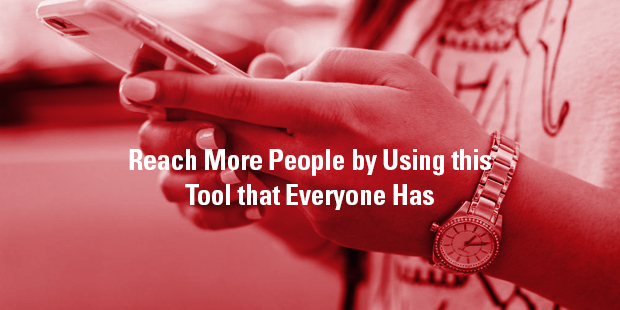
Reach More People by Using this Tool that Everyone Has
59% of millennials who grew up in church have dropped out.
Why? That’s a huge can of worms. There are plenty of theories – some based on data and others based on mere opinion.
I believe at least one reason why we’ve failed to reach this younger generation of people has to do with the way we communicate about who we are and what we believe.
We generally tend to promote the church either through mass-marketing methods, like direct mail or print advertising, or we don’t promote the church at all and just assume people should know we exist and feel some moral obligation to find us on the weekend.
In the last decade, our culture has experienced a massive shift, thanks in part to technological advances. It’s not all bad. In fact, if we understand it, it’s actually quite good.
When the internet first went online, businesses and news organizations – and eventually a lot of churches – adopted it as a mass communication tool. But things changed with the creation of various social networks like Facebook, Twitter, and Instagram. Social media forced businesses and news organizations to focus more on personalization.
The church is starting to catch on and adopt social media platforms as a means of connecting with people and spreading a message of hope. We’re a bit behind, of course, but we’re starting to catch up.
As the church begins to utilize social technologies, the youngest generation may already be moving on from social networks to much more personal means’ of communicating, especially texting.
Text-messaging, as an outreach and communication tool, is HUGE!
I believe rather strongly that we should stop asking people to turn their cell phones OFF during worship services and instead, ask them to turn them ON and use them…
- For accessing Bible apps
- To interact with the service
- To snap and share photos and videos
- To check-in and share about their church
According to Text In Church,
- 23 billion texts are sent each day
- 90% of texts are read within 3 minutes
- 45% of texts receive a reply
The question is, how can the church tap into text messaging as a means of reaching more people and making more disciples?
While we’re still learning in this arena, here are some thoughts and practices that may be worth implementing and experimenting with. Some of these, my church is already doing, and some of them, we’re just talking about.
1. Helping people plan their first visit.
Our church website utilizes a service from Church Hero called Plan Your Visit.
It allows people, from any page of our website, to click a button and let us know they’re coming. We then, in turn, send them a text with information about the service time they chose, and then we send them a reminder text.
Our First Impressions Director prepares one of our first-time guest gift bags especially for them with their name on it.
2. Allowing people to text-to-give.
We manage all of our online giving with Planning Center Online. There are tons of competitors on the market and each has their advantages, but Planning Center’s Online Giving app integrates seamlessly with our people tracking, volunteer scheduling, kids’ check-in apps, etc.
One of the features we use is the text-to-give feature. Donors can send a dollar amount to a five-digit phone number via text and they’ll be guided through the process of making sure it gets to us. Once they’ve given by text once, it’s set up forever and is simple and easy to do.
This is especially helpful for one-time short campaigns and special causes. If we’re supporting a local nonprofit one weekend, we can ask people to designate $5 or $10 or more for that particular ministry by simply sending a text.
3. Being interactive during the message.
Our church doesn’t have a physical office. Therefore we don’t need a landline phone system. We just use a free Google Voice number instead. During the service, we can ask people to take an immediate action by sending us a text message via our Google number.
During a message, this might include texting us with follow-up questions. When making announcements, it might mean that people can register for an event or sign up to volunteer via text message.
4. Communicating with subgroups and ministry teams.
We use Facebook groups excessively within our church. Every volunteer team and almost every small group has a Facebook group. The problem is, not everyone is on Facebook and not everyone who is on Facebook pays attention to it. This is especially true of a bunch of men in our church.
So we use group texts to communicate about special Bible studies, volunteer opportunities, and events as well as weather cancellations and other important notices.
For this purpose, we use Text In Church, created by my friend, Tyler Smith.
Text In Church lets us create groups and use keywords to manage those groups. People can opt in, and opt out, and manage their messages.
5. Creating text message sequences (automatically-sending messages).
When someone uses our Plan Your Visit button, we can add their number into Text In Church and send them a series of text messages designed to introduce them to our church. The same is true when someone visits for the first time – they can send a text to a number with a keyword and we can follow up automatically.
We can also create discipleship-oriented message sequences. If we do a 40-day spiritual growth campaign or a 6-week message series on a particular topic and want to include daily reminders to pray or daily devotional messages, we can create all of that within Text In Church.
Obviously, we need to respect the privacy of everyone and avoid spamming people with unwanted or uninvited messages. But when we have permission, text messaging can become one of the most personal and individual ways to follow up with people and reach more of our community.
> Read more from Brandon here.

Tags: Brandon Cox, Communication, Texting

























